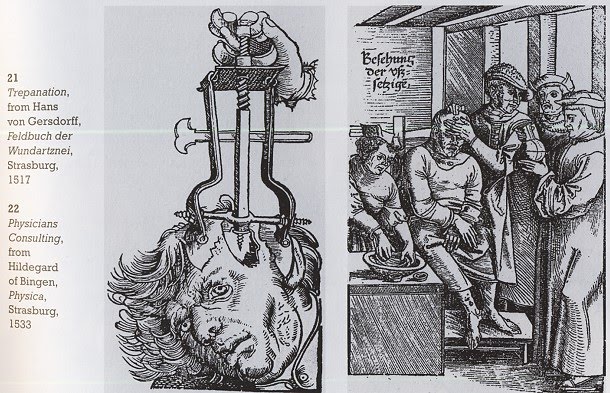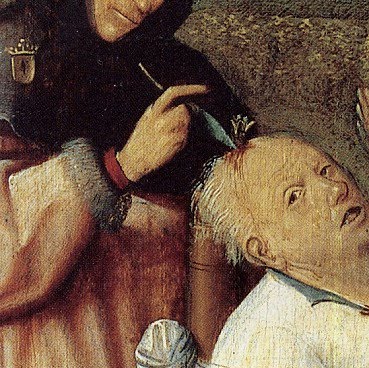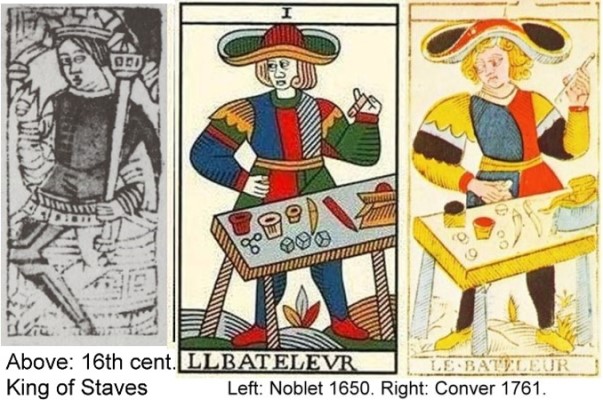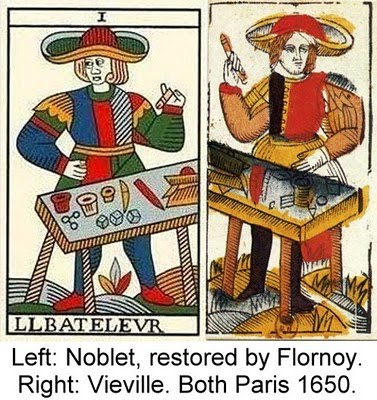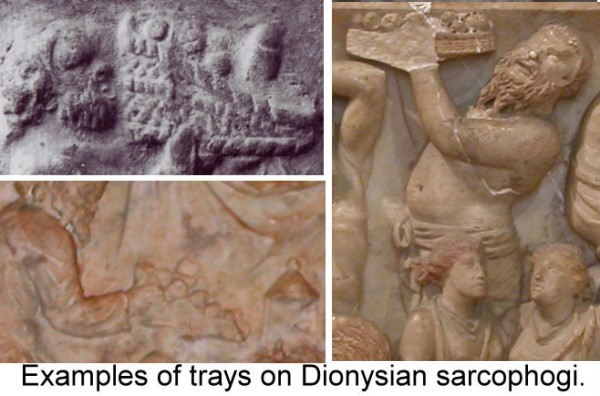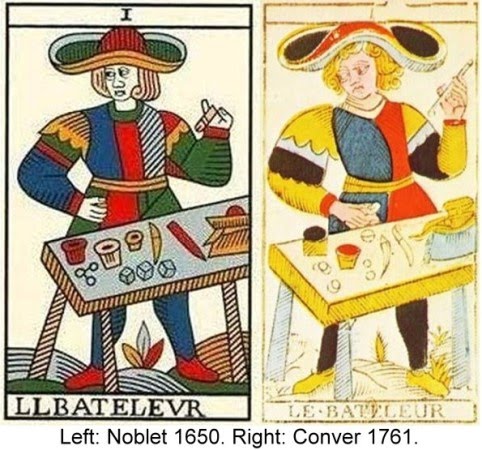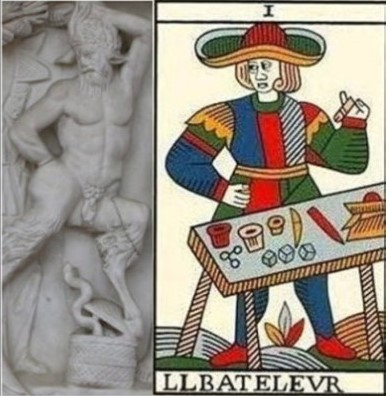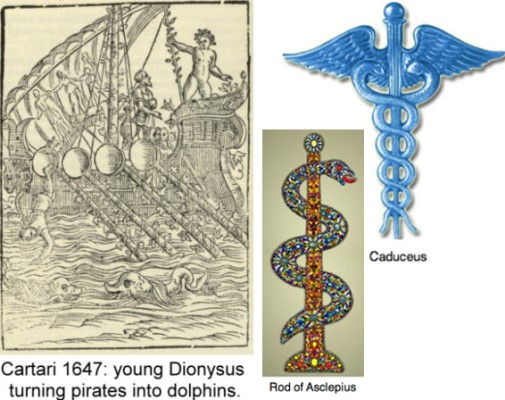I want to say something about the Magician's wand, among other things. It's been a topic of much conversation, so perhaps I am repeating what has already been said, but here I go anyway. Whether the Noblet Bateleur's wand is meant to look like that, or it has a piece of wood broken off the plate, it is clearly a phallic symbol.
First, if the way it looks is not an accident (and I see no jagged edge on the image at
http://www.tarot-history.com/Jean-Noble ... eleur.html to suggest that it is), it parallels a 16th century King of Staves in Kaplan Vol. 2. Staves, from the PMB onwards, is a suit of the countryside, vegetation, and fertility. The PMB court figures in Staves all have green sleeves or gloves(see
http://www.tarot.com/tarot/decks/index. ... &cardID=32 and following); we know, from the song "Greensleeves" if nowhere else, that this motif has sexual connotations (see
http://en.wikipedia.org/wiki/Greensleeves). In the Noblet, the Queen is shown bare-breasted, and the Page is admiring his big stick (view at
http://letarot.com/jean-noblet/pages/je ... neurs.html). The phallic finger on our 16th century King of Staves is not out of place. In it and the Noblet, you will notice only two other fingers, suggesting testicles.
Either as wand or finger, its placement is sexually suggestive. Both in the Noblet and the Conver (above), it points directly at the object in his other hand, something circular: the circle is an image of the feminine organ. The objects in the two hands go together.
Comparing the Noblet with the Vieville, on the other hand, we see that the angle of the wand parallels the angle of the object half out of the purse on the table, suggesting a parallel meaning: the "virilia of Dionysus," as Clement of Alexandria put it (
Exhortation to the Greeks 2.15, at
http://www.theoi.com/Georgikos/Zagreus.html). Daimonax on his site has several pictures, from Dionysian-themed Roman sarcophagi, of such objects on the trays carried in Dionysian initiations (
http://www.bacchos.org/tarothtm/0et9mathermite2.html, lower part of web page). Here are some examples of trays, with the "virilia" fairly evident in the two on the left:
Such sarcophagi, probably including the ones pictured, were well known during the Renaissance and after, through engravings if nowhere else. According to art historian Richard Asti, the 16th century Italian painter Giulio Romano used one, or an engraving of it, as inspiration for an erotic drawing ("Giulio Romano as Designer of Erotica," in Janet Cox Rearick, ed.,
Giulio Romano Master Designer, p. 47).
There is also a plant shaped like a phallus and testicles on the ground. So we have the male organ of generation on three levels. The Conver is more sexually balanced: the plant evokes the feminine external genitalia, as I learned from Jodorowsky (
Via de la Tarot, Spanish edition, section on Bateleur).
What does this symbolism mean? Well, the phallus of Dionysus was in his cult a magical object, as I argued in a recent post on the Fool (
viewtopic.php?f=23&t=383&start=20#p6495). It was a symbol of regeneration, new birth; it is the Dionysian equivalent of the body and blood of Christ. The object in the basket was sometimes represented as a snake, another phallic symbol.
Snakes, besides being the phallus, also symbolic of regeneration because of their shedding their skins.
At the same time the wand is a an instrument of more familiar shape-changing magic, of which Dionysus was a natural adept. His wand was the
thyrsis, a fennel stalk perhaps tipped with a pine cone. In the 1647 Cartari illustration below, he is shown responding to pirates who want to hold him captive: he is changing them into dolphins. And in the context of amateur doctoring, in which itinerant conjurors were apparently involved, the wand was also reminiscent of both Aesclepius's staff of healing, around which a single snake coiled, and the double-snaked caduceus of Hermes, which the alchemists, as Hermetics, used as their symbol (according to
http://medicineandman.com/index.html), presumably as followers of Hermes Trismegistus.
The three levels on the Marseille-style cards are the traditional threesome of Platonic philosophy, Hermes Trismegistus ("Thrice-Greatest"), and alchemy: spirit, soul, and body; upper world, middle world, lower world; heaven, purgatory, and hell; father, holy spirit, son; sefirot, angels, and humans; etc.
As for the other objects on the table (besides the purse), they correspond to the toys that the Titans used to lure the child Dionysus to his death, i.e. the temptations of this world. Clement of Alexandria quoted from an Orphic hymn, which spoke of "top, wheel and jointed dolls, with beauteous fruit of gold from the clear-voiced Hesperides." There were also "the knuckle-bone, the ball, the spinning-top, apples, wheel, mirror, fleece" (
Exhortation to the Greeks 2.15, at
http://www.theoi.com/Georgikos/Zagreus.html). These objects were all placed on the tray carried in the Dionysian initiations pictured on Roman sarcophagi. The message, I think, was that earthly things, including even Dionysus's own gift of wine, can lure us away from the sources of true happiness. Yet wine was also, in the ancient writers quoted by Cartari an inspirer of exalted states of consciousness. Knuckle-bones of course are the implements of gambling.
[Note added 4/25/10: This paragraph needs more work, if it should be in at all.] Another detail that adds to my interpretation is the apparent instability of the table. It does not actually have three legs, it just looks that way, because the table leg and the Bateleur's leg are the same color. But the look of three legs, along with the bumpy ground, and on the Noblet the stream running underneath, create an atmosphere of instability. I think it is the instability of the world of illusion. The stream suggests that the table, and the Bateleur himself, is a bridge between the two worlds, the flux of becoming and the repose of being.
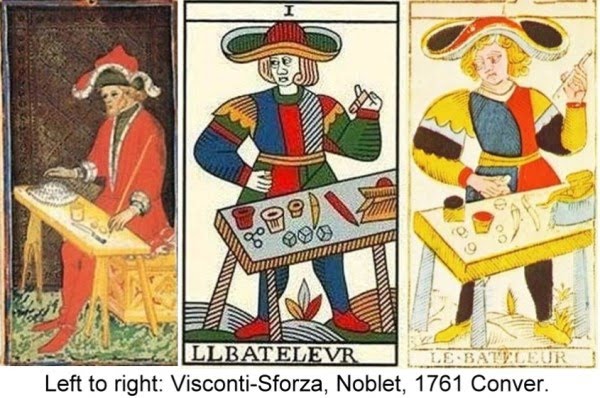
And finally there is the question of the broad-brimmed hat. I doubt if it is the symbol for infinity; that wasn't in use until the 17th century, and the hat is older. It could be a double oroborus, as others have pointed out, the snake not just turning back on itself but twisting as it does so. I have two other explanations. It first appears in the PMB. As such, it could be left over from an earlier Milanese deck, the Michelino, where the card for Mercury showed a man in a "galero," or cardinal's hat, as Ross Caldwell interprets (
http://trionfi.com/0/b/07/index.php, in his commentary on the Marziano manuscript). The hat in the PMB card is red, the color of a cardinal's hat. In that case, the Magician is posing as a high-level Catholic priest, just below the Pope. The Marseille Bateleur is rather young looking; well, Cardinals were often appointed young, especially if they were "nephews" of the Pope.
My second explanation probably applies only to the hat as it was taken up by the Marseille and its 16th century forerunners, as it depends on certain imagery related to Egypt, for which I have no direct evidence before around 1522. My hypothesis is that the hat would have been seen as the horns of a particular species of Egyptian sheep, with horns that extended out horizontally from its head. Why (not to mention, how) would Europeans be familiar with such sheep? We have to understand that "Egyptomania" was not a phenomenon that started with Napoleon. In the 15th century, many educated Italians went to Egypt as traders and collectors of antiquities; an example is the traveler-collector Chiriaco da Ancone, who visited Egypt (as far as Sakkara, near Cairo) in 1436 and wrote about his travels (Curran.
The Egyptian Renaissance: The Afterlife of Ancient Egypt in Early Modern Italy, p. ). He also visited art patrons, e.g. Leonello d'Este in 1449 (Venturi,
North Italian Painting of the Quattrocento: Emilia, p. 38f), a fact of interest these days mainly because he also wrote about the paintings of Muses he saw at Belfiore. Art patrons listened; there was an avalanche of attempts to convey the images and ideas of ancient Egypt (see Curran). Lazarelli, for example, did "translations" of hieroglyphics. Later there was the mummy trade; ground up as a powder, they were used in the treatment of syphilis (
http://www.jstor.org/pss/751090). In the 16th century, Egyptomania spread to France (Hornung,
The Secret Lore of Egypt and its Impact on the West).
What is of interest ia how people might have re-interpreted the Bateleur's hat as a result of "Egyptomania." in the 16th century, odd horizontally extended horns appear on numerous figures, including rams, in the so-called "Bembo tablet." Of Roman origin, c. 2nd century, it attracted much attention after it was acquired by Pietro Bembo around 1527. Exactly when it came to scholars' and art patrons' attention is unclear, as it seems to have been written about in 1522, according to Curran. But after 1527, drawings started being made of it (by Vico among others, according to Curran) and interpretations ran rampant.
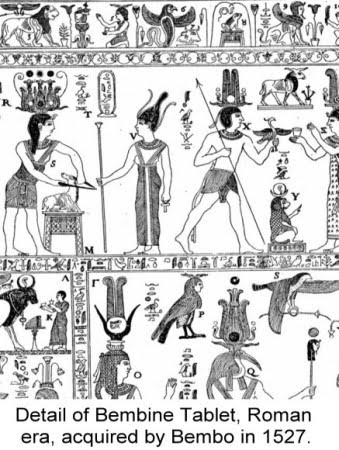
The horns aren't biologically appropriate for any of the figures that have them on the Tablet. But two for which they would be appropriate are the ram and the bull. The bull was identified with Osiris; as such, Pope Alexander VI even claimed descent from the Osiris-Bull Apis, and had his initials painted on one in his Vatican apartments. But as the trump with Roman numeral I, the Bateleur is more appropriate for the ram, which was recognized as Aries, the sign of the zodiac that begins the yearly cycle.
(Rams with such horns actually did appear as Aries in the Greco-Roman era Dendera zodiacs (images below from Desroches-Noblecourt,
Le Fabuleux Heritage de l'Egypte, p. 123).
It makes sense that 16th century Europeans would have seen images of these zodiacs, as Dendera and its temple were on a trade route between the Red Sea and the Nile (shown as a road on modern maps), and it was already of interest for its portrait of Cleopatra on the outside. But I have no evidence for when images from these zodiacs reached Europe.)
Given the various shapes on the Tablet, people might also have associated this ram with Atem-Re, the mighty creator-god of the temples of Luxor. As such he would, for 16th century Europeans, be the creator of this world of illusion into which, for Europeans, Adam and Eve were thrown, a creation out of four basic elements, in the tarot corresponding to the one who creates an imaginal world out of the suits and trumps. It is like the oracles in the ancient tales (and the parables of Jesus?): their words create a web of delusion for some, but also, for those with ears to hear, give the tools, or cards, by which to find one's way home.
I will sum up by invoking the god himself. Dionysus had hundreds of one-word epithets, beginning with all 24 letters of the Greek alphabet except two. I find a certain ritual resonance to assigning to each card an epithet starting with a different letter of the alphabet, in sequence. I decided to start with the Fool as Alpha. If so, the Magician would be Beta. Going in order, it turned out that an appropriate epithet fit every card. I could also have gone the other way and given the Fool Omega and the Magician Psi, but I haven't worked out whether all 22 make sense that way. In that schema, Dionysus as Bateleur would be Pseudanor, Falsely Virile One--yes, that is actually one of his epithets--in the same invocation as that below.
O Dionysos Botryophoros, Bearer of the Grape Clusters, may your illusions lead us to knowledge.
I will also say something about the card's possible significance in a reading, from this very narrow historical focus on the wand and a basic understanding of the itinerant Renaissance conjuror, as already presented by others and myself in this thread. In a reading, the card might suggest a confrontation with the Trickster archetype, entrapping the naive and the ignorant but leading the wise toward the divine. Sex, addictive substances, money, and power are the usual culprits.

